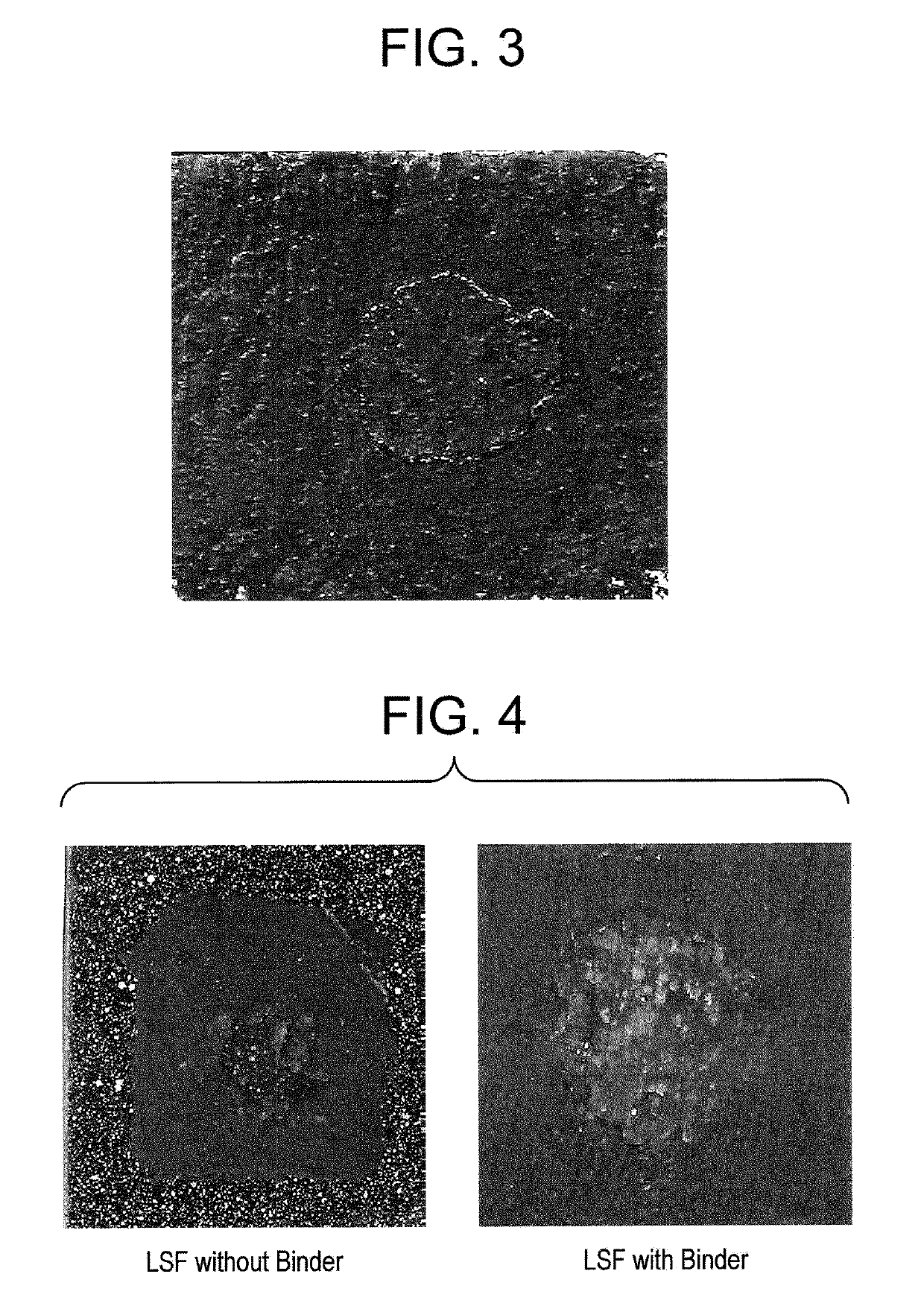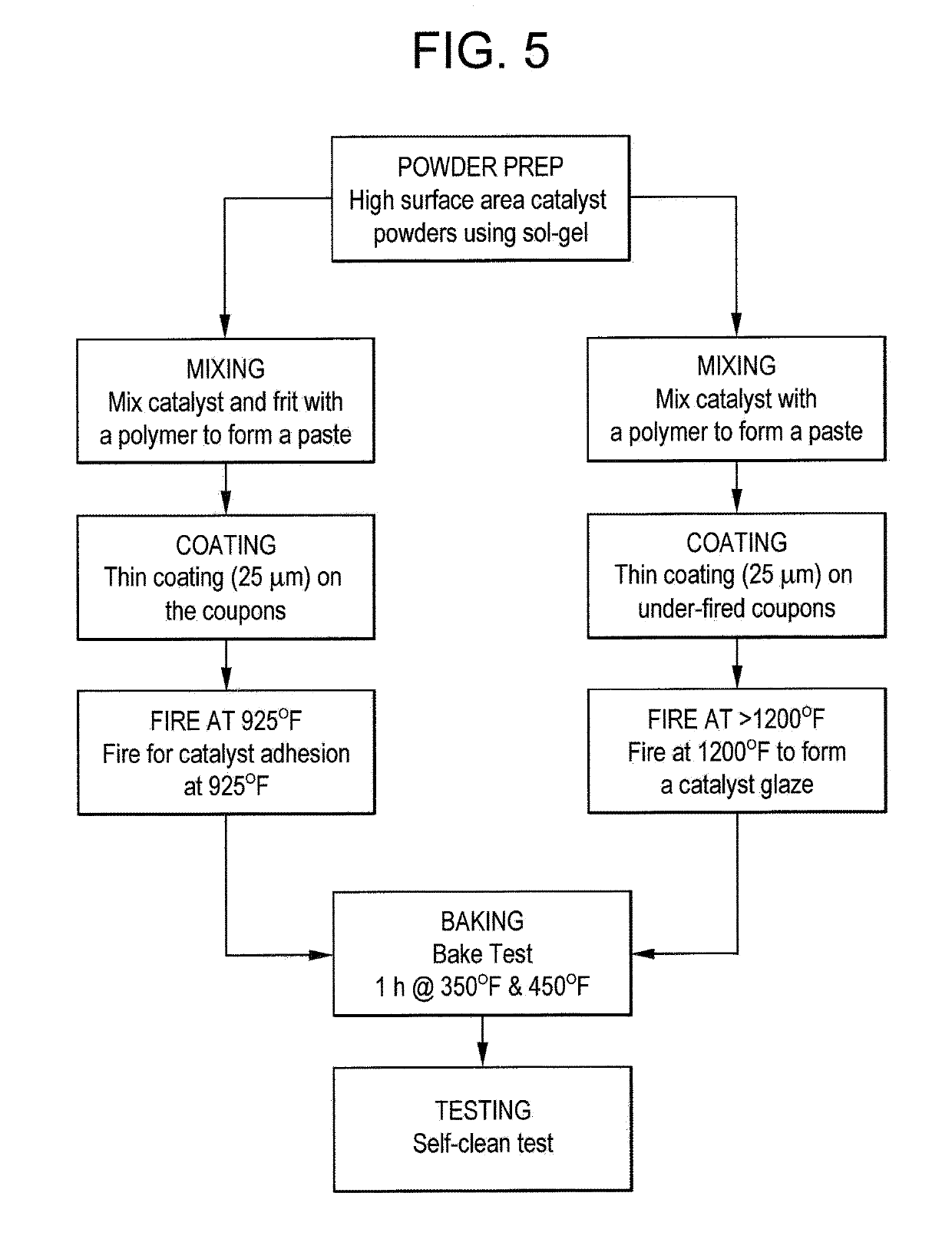Pyrocatalytic coatings for heating devices
- Summary
- Abstract
- Description
- Claims
- Application Information
AI Technical Summary
Benefits of technology
Problems solved by technology
Method used
Image
Examples
example 1
[0030]In this example, various catalysts were individually mixed in α-terpineol up to 70wt % using a three-roll mill or a high speed centrifugal mixer to form a homogeneous paste. The catalysts included lanthanum strontium ferrite (LSF), lanthanum strontium cobaltate (LSC), strontium samarium cobaltate (SSC), lanthanum strontium cobalt ferrite (LSCF), cerium oxide (CeO2), and cerium samarium oxide (Ce(Sm)O2). The catalyst paste was painted onto an oven panel section. The coated panel section was dried in an oven at 200° F. (93.3° C.) for 12 hours and then calcined at 925° F. (496.1° C.) in air for 2 hours.
example 2
[0031]In this example, the coated panels of example 1 were evaluated to determine the cleanability effectiveness. Approximately 5 g of a processed cheese product commercially available under the trade name CheezWhiz from Kraft foods was used to evaluate the cleanability of the oven panel. CheezWhiz was applied as a food stain to the coated panel using a wooden stick approximately 3 millimeters (mm) in diameter. The diameter of the applied food stain was between 5 mm to 10 mm. The control in the experiment was a standard oven panel cut 1.5″×1.5″ from a GE oven currently used in the market.
[0032]The testing procedure included heating the panel to 350° F. (176.7° C.) for 1 hour at which time the heat was increased to 450° F. (232.2° C.) for 1 hour. The panels were then cooled to room temperature. After staining the oven panel by heating at the elevated temperatures as noted above, all samples had food stain that could be removed only through scrubbing. The samples were then exposed to ...
example 3
[0033]In this example, under-fired panels were used. The oven panel is typically made of two enamel coatings, the ground coat and the top-coat. Top-coat is applied mainly for aesthetics reasons. This coat is responsible for the glaze that is observed on an oven panel. Calcination proceeds after each coat. Hence, oven panels with ground coat and an unfired top-coat were considered for the study. These panels form the top-coat glaze when heated to temperatures greater than 1150° F.
[0034]Of the catalysts described above, LSC and LSF were each individually coated on the under-fired oven panels and calcined at 1200° F. (648.9° C.) for 5 minutes. No SiO2 binder was added. A glossy, rough surface was formed with the catalytic material on top conducive for cleaning. The panels were tested as described earlier. The results for the oven panels coated with LSF and LSC are shown in FIGS. 2 and 3, respectively. Note that after the self-clean cycle as described above there is no imprint of the fo...
PUM
| Property | Measurement | Unit |
|---|---|---|
| Temperature | aaaaa | aaaaa |
| Temperature | aaaaa | aaaaa |
| Temperature | aaaaa | aaaaa |
Abstract
Description
Claims
Application Information
 Login to View More
Login to View More - R&D
- Intellectual Property
- Life Sciences
- Materials
- Tech Scout
- Unparalleled Data Quality
- Higher Quality Content
- 60% Fewer Hallucinations
Browse by: Latest US Patents, China's latest patents, Technical Efficacy Thesaurus, Application Domain, Technology Topic, Popular Technical Reports.
© 2025 PatSnap. All rights reserved.Legal|Privacy policy|Modern Slavery Act Transparency Statement|Sitemap|About US| Contact US: help@patsnap.com



